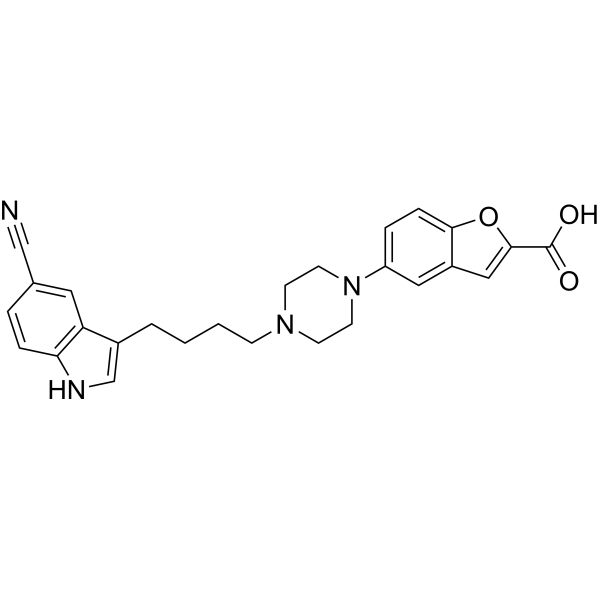
| 规格 | 价格 | 库存 | 数量 |
|---|---|---|---|
| 1mg |
|
||
| 5mg |
|
||
| Other Sizes |
|
| 靶点 |
vilazodone metabolite
|
|---|---|
| 体外研究 (In Vitro) |
Vilazodone (VLZ)和代谢物的半定量估计是在百分比计数的基础上进行的。VLZ和在尿液、粪便和血浆中形成的每种代谢物(M1-M12)的相对百分比丰度总结于图2 (a-c)。由于代谢研究没有任何参考标准,代谢物的估计可能存在不确定性,因此使用离子计数对代谢物进行半定量估计。[32,33]本研究发现,VLZ在所有体内样本中均存在,粪便中的比例较高(13.93%)。这篇文章受版权保护。版权所有。在尿中,VLZ被广泛代谢,导致九种代谢物的形成。尿液中主要代谢物为M4(10.86%)和M11(27.02%),其他代谢物较少。代谢产物M6(47.7%)和M2(11.69%)在包括VLZ在内的粪便中形成较高水平,而其他代谢物较少。血浆中检测到3种代谢物,其中代谢物M8(3.54%)是唯一较高水平形成的代谢物,其他代谢物M4和M11含量较少。在HLM和RLM中均检测到少量的M4和M8代谢物。[1]
|
| 体内研究 (In Vivo) |
维拉唑酮是一种选择性血清素再摄取抑制剂(SSRI),用于治疗重度抑郁症(MDD)。广泛的文献检索发现很少有关于维拉唑酮体内和体外代谢的报道。因此,我们报道了利用超高效液相色谱/四极杆飞行时间串联质谱(UPLC/Q-TOF/MS/MS)对维拉唑酮进行体内和体外代谢鉴定和结构表征以及代谢产物的硅毒性研究。[1]
方法:采用Sprague-Dawley大鼠口服维拉唑酮后0 ~ 48 h的不同时间间隔采集血液、尿液和粪便样本,鉴定维拉唑酮在体内的代谢产物。用人肝微粒体(HLM)和大鼠肝微粒体(RLM)进行体外代谢研究。样品的制备采用优化的样品制备方法,包括蛋白质沉淀和固相萃取。利用LC/ESI-MS/ ms对其代谢产物进行了鉴定和表征[1] 结果:在体内和体外基质中共鉴定出12种代谢物(M1-M12),并通过LC/ESI-MS/MS进行了表征。大多数代谢物存在于尿液中,少数代谢物存在于粪便和血浆中。体外实验中观察到两种代谢物。一项基于百分比计数的半定量研究表明,代谢产物M11、M6和M8分别在尿液、粪便和血浆中含量较高。[1] 结论:采用LC/ESI-MS/MS对12种代谢物的结构进行了分析。研究表明,维拉唑酮的代谢过程包括羟基化、二羟基化、葡萄糖醛酸化、氧化脱胺、脱烷基、脱氢和二氧化。所有代谢物都使用硅工具筛选毒性。[1] |
| 酶活实验 |
体外代谢物生成[1]
体外代谢物生成研究按照报道的方法进行。为了进行体外代谢研究,将25µl HLM(人肝微粒体)和RLM(大鼠肝微粒体)混悬液(20 mg ml-1)分别加入两个不同的epppendorf管中,其中分别含有420µl 100 mM磷酸盐缓冲液(pH 7.4)。微粒体在37℃下预处理5分钟。每管加入1mM原液5µl。通过添加50µl 10 mM NADPH(辅因子)启动代谢反应。对照样品由磷酸盐缓冲液代替辅助因子。首先取100µl的等分液作为零时间点样品,用等体积的冷冻ACN立即淬火,然后进行涡旋。第二份等温物(400µl)在37°C的培养摇床中连续摇(50 rpm)孵育2小时,随后以类似的方式处理。所有样品在10000 rpm下离心10 min,上清液进行固相萃取(SPE)富集代谢物,去除干扰。 |
| 动物实验 |
For in vivo metabolic profiling of VLZ (Vilazodone), male Sprague–Dawley rats (200-220 gm) were used.[1]
In vivo Sample preparation Vilazodone (VLZ) was orally administered to rats in the form of 0.5% carboxymethyl-cellulose suspension at a dose of 20 mg kg-1 . Animals were given access to the food after 4 h of the drug administration. Blood samples (0.2 mL) were collected from rats (n=6) in 0.5 mL eppendorf tubes through retro-orbital route according to known pharmacokinetics. The plasma was separated from the blood samples by centrifugation at 6000 rpm for 10 min at 4 °C and stored at -80 °C until analysis. Protein precipitation was done by addition of three volumes of ACN to urine and plasma followed by vortexing for 2-3 min and centrifugation at 10000 rpm for 10 min. The supernatant was concentrated via nitrogen evaporation and the remaining aqueous portion was subjected to SPE using strata C18-E cartridges. The eluted portion was submitted for analysis. The faeces and urine This article is protected by copyright. All rights reserved. samples were collected before drug administration and at intervals of 0-8, 8-24, 24-48 h post dose from another set of animals (n= 6). Sample aliquots were pooled together and stored at - 80 °C until analysis. In case of faeces, equal volumes of water and ACN were added. The mixture was vortexed to slurry which was subjected to centrifugation at 10000 rpm for 10 min and treated in a similar way like urine and plasma samples.[1] |
| 参考文献 | |
| 其他信息 |
The present study describes identification and characterization of 12 metabolites of VLZ in biological matrix (rat urine, faeces, plasma, HLM and RLM) by LC-MS/MS technique. Sample preparation was carried out by protein precipitation followed by solid phase extraction. The systematic structural characterization of the metabolites (M1-M12) was carried out by comparison of mass spectrum of the VLZ with those of metabolites and accurate mass measurement studies. Hydroxylated and dihydroxylated metabolites were formed in in vitro studies. The in vivo biotransformation pathway of VLZ includes hydroxylation, glucuronidation, dehydrogenation, oxidative deamination etc., In silico screening of metabolites was carried out using TOPKAT software. The study provides comprehensive information on the in vivo and in vitro drug metabolism when administered in rats. Structural knowledge of metabolites can be useful in developing new molecules with improved efficacy.[1]
|
| 分子式 |
C26H26N4O3
|
|---|---|
| 分子量 |
442.5096
|
| 精确质量 |
442.2
|
| CAS号 |
163521-19-5
|
| 相关CAS号 |
Vilazodone Hydrochloride;163521-08-2;Vilazodone;163521-12-8
|
| PubChem CID |
11201569
|
| 外观&性状 |
White to light yellow solid powder
|
| LogP |
4.631
|
| tPSA |
96.5
|
| 氢键供体(HBD)数目 |
2
|
| 氢键受体(HBA)数目 |
6
|
| 可旋转键数目(RBC) |
7
|
| 重原子数目 |
33
|
| 分子复杂度/Complexity |
730
|
| 定义原子立体中心数目 |
0
|
| InChi Key |
RSXUEYFLDNUILS-UHFFFAOYSA-N
|
| InChi Code |
InChI=1S/C26H26N4O3/c27-16-18-4-6-23-22(13-18)19(17-28-23)3-1-2-8-29-9-11-30(12-10-29)21-5-7-24-20(14-21)15-25(33-24)26(31)32/h4-7,13-15,17,28H,1-3,8-12H2,(H,31,32)
|
| 化学名 |
5-[4-[4-(5-cyano-1H-indol-3-yl)butyl]piperazin-1-yl]-1-benzofuran-2-carboxylic acid
|
| 别名 |
5-(4-(4-(5-Cyano-1H-indol-3-yl)butyl)piperazin-1-yl)benzofuran-2-carboxylic acid; Vilazodone Carboxylic acid; Vilazodone metabolite M10; 5-[4-[4-(5-cyano-1H-indol-3-yl)butyl]piperazin-1-yl]-1-benzofuran-2-carboxylic acid; 93K783WZV4; 2-Benzofurancarboxylic acid, 5-[4-[4-(5-cyano-1H-indol-3-yl)butyl]-1-piperazinyl]-; 5-[4-[4-(5-cyano-1H-indol-3-yl)butyl]-1-piperazinyl]-2-Benzofurancarboxylic acid;
|
| HS Tariff Code |
2934.99.9001
|
| 存储方式 |
Powder -20°C 3 years 4°C 2 years In solvent -80°C 6 months -20°C 1 month |
| 运输条件 |
Room temperature (This product is stable at ambient temperature for a few days during ordinary shipping and time spent in Customs)
|
| 溶解度 (体外实验) |
DMSO : ~4 mg/mL (~9.04 mM)
|
|---|---|
| 溶解度 (体内实验) |
注意: 如下所列的是一些常用的体内动物实验溶解配方,主要用于溶解难溶或不溶于水的产品(水溶度<1 mg/mL)。 建议您先取少量样品进行尝试,如该配方可行,再根据实验需求增加样品量。
注射用配方
注射用配方1: DMSO : Tween 80: Saline = 10 : 5 : 85 (如: 100 μL DMSO → 50 μL Tween 80 → 850 μL Saline)(IP/IV/IM/SC等) *生理盐水/Saline的制备:将0.9g氯化钠/NaCl溶解在100 mL ddH ₂ O中,得到澄清溶液。 注射用配方 2: DMSO : PEG300 :Tween 80 : Saline = 10 : 40 : 5 : 45 (如: 100 μL DMSO → 400 μL PEG300 → 50 μL Tween 80 → 450 μL Saline) 注射用配方 3: DMSO : Corn oil = 10 : 90 (如: 100 μL DMSO → 900 μL Corn oil) 示例: 以注射用配方 3 (DMSO : Corn oil = 10 : 90) 为例说明, 如果要配制 1 mL 2.5 mg/mL的工作液, 您可以取 100 μL 25 mg/mL 澄清的 DMSO 储备液,加到 900 μL Corn oil/玉米油中, 混合均匀。 View More
注射用配方 4: DMSO : 20% SBE-β-CD in Saline = 10 : 90 [如:100 μL DMSO → 900 μL (20% SBE-β-CD in Saline)] 口服配方
口服配方 1: 悬浮于0.5% CMC Na (羧甲基纤维素钠) 口服配方 2: 悬浮于0.5% Carboxymethyl cellulose (羧甲基纤维素) 示例: 以口服配方 1 (悬浮于 0.5% CMC Na)为例说明, 如果要配制 100 mL 2.5 mg/mL 的工作液, 您可以先取0.5g CMC Na并将其溶解于100mL ddH2O中,得到0.5%CMC-Na澄清溶液;然后将250 mg待测化合物加到100 mL前述 0.5%CMC Na溶液中,得到悬浮液。 View More
口服配方 3: 溶解于 PEG400 (聚乙二醇400) 请根据您的实验动物和给药方式选择适当的溶解配方/方案: 1、请先配制澄清的储备液(如:用DMSO配置50 或 100 mg/mL母液(储备液)); 2、取适量母液,按从左到右的顺序依次添加助溶剂,澄清后再加入下一助溶剂。以 下列配方为例说明 (注意此配方只用于说明,并不一定代表此产品 的实际溶解配方): 10% DMSO → 40% PEG300 → 5% Tween-80 → 45% ddH2O (或 saline); 假设最终工作液的体积为 1 mL, 浓度为5 mg/mL: 取 100 μL 50 mg/mL 的澄清 DMSO 储备液加到 400 μL PEG300 中,混合均匀/澄清;向上述体系中加入50 μL Tween-80,混合均匀/澄清;然后继续加入450 μL ddH2O (或 saline)定容至 1 mL; 3、溶剂前显示的百分比是指该溶剂在最终溶液/工作液中的体积所占比例; 4、 如产品在配制过程中出现沉淀/析出,可通过加热(≤50℃)或超声的方式助溶; 5、为保证最佳实验结果,工作液请现配现用! 6、如不确定怎么将母液配置成体内动物实验的工作液,请查看说明书或联系我们; 7、 以上所有助溶剂都可在 Invivochem.cn网站购买。 |
| 制备储备液 | 1 mg | 5 mg | 10 mg | |
| 1 mM | 2.2598 mL | 11.2992 mL | 22.5984 mL | |
| 5 mM | 0.4520 mL | 2.2598 mL | 4.5197 mL | |
| 10 mM | 0.2260 mL | 1.1299 mL | 2.2598 mL |
1、根据实验需要选择合适的溶剂配制储备液 (母液):对于大多数产品,InvivoChem推荐用DMSO配置母液 (比如:5、10、20mM或者10、20、50 mg/mL浓度),个别水溶性高的产品可直接溶于水。产品在DMSO 、水或其他溶剂中的具体溶解度详见上”溶解度 (体外)”部分;
2、如果您找不到您想要的溶解度信息,或者很难将产品溶解在溶液中,请联系我们;
3、建议使用下列计算器进行相关计算(摩尔浓度计算器、稀释计算器、分子量计算器、重组计算器等);
4、母液配好之后,将其分装到常规用量,并储存在-20°C或-80°C,尽量减少反复冻融循环。
计算结果:
工作液浓度: mg/mL;
DMSO母液配制方法: mg 药物溶于 μL DMSO溶液(母液浓度 mg/mL)。如该浓度超过该批次药物DMSO溶解度,请首先与我们联系。
体内配方配制方法:取 μL DMSO母液,加入 μL PEG300,混匀澄清后加入μL Tween 80,混匀澄清后加入 μL ddH2O,混匀澄清。
(1) 请确保溶液澄清之后,再加入下一种溶剂 (助溶剂) 。可利用涡旋、超声或水浴加热等方法助溶;
(2) 一定要按顺序加入溶剂 (助溶剂) 。